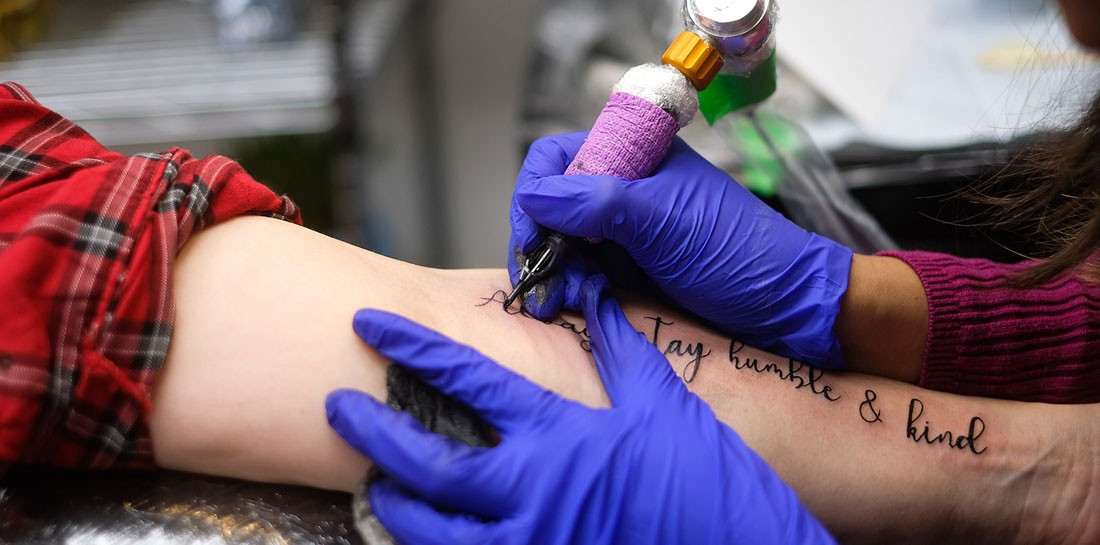Winnipeg inkmasters: not just a boys’ club
The kickass women taking Winnipeg’s tattoo industry by storm
With images of tough biker dudes and full sleeves in mind, it can be easy to imagine tattooing as an exclusive boys’ club for the tough and mighty. This is far from the truth, as tattoos have become increasingly popular with folks of all genders, and Winnipeg has a variety of women powerhouse artists.
One of Winnipeg’s most popular and frequented shops is Metamorphosis Body Art, co-founded by Nadine Mitchell, whose current roster of artists is predominantly women. Though Metamorphosis Body Art is a more well-known stop, it is not the only place to find exceptional women talent.
The starting point
South of Heaven Tattoos and Body Piercing on St. Mary’s Road is home to apprentice Katie Moon and her mentor, Karen Melia. The two have been friends for many years, but Melia offered Moon a position as her apprentice in January of 2019.
Moon says “my dad was an artist as a hobby” and that her artistic family atmosphere sparked a lifelong love for art. Melia has a similar backstory, saying that “my mom was very crafty growing up, so I was always doing artistic things.”
While it might be easy to think tattoo artists materialize into the world with a passion for art and skills to boot, it can be difficult to navigate the politics and environment of tattoo shops and stand out from the crowd.
“People tend to think that tattoo artists are this weird subgroup of really cool people, and they’re somehow different than other people, and we get put on these weird pedestals." -- Katie Moon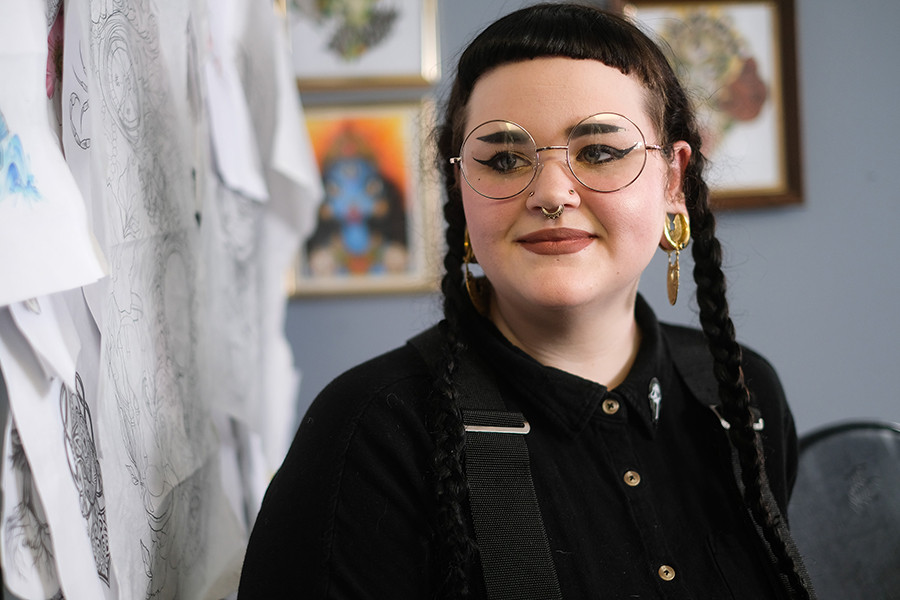
Moon did not initially believe she had the capabilities to draw things outside of her comfort zone, saying “I’m like a one-trick pony,” but Melia encouraged her to pursue tattooing.
In order to start working in the industry, “you’ve got to know someone to get you in the door, and you have to sell yourself. It’s such a hustle, especially at the beginning. It’s such a hard thing to develop clientele, develop a reputation and sell your art,” Melia says.
This is especially true for artists like Foram Patel, who is currently situated at Ink Noir Tattoo Studio on Marion Street. Patel is new to Canada, having moved from Vadodara, Gujarat in India, where she first developed her interest in art and tattoos.
Although she is not newly apprenticed, she found similar barriers to finding work. Patel says that upon applying to tattoo studios, the response would often be “you have nice work, but we are looking for more experienced artists, because we want somebody with a client base.”
For Moon and Melia, their trust and respect for each other was the foundation of their professional relationship. “I would always come back to Karen, because I trusted her,” Moon says.
“She was the first person in a tattoo shop that spoke to me with respect. And she was the first person that I ever encountered when I walked into a shop that didn’t talk to me like I was stupid.”
“People tend to think that tattoo artists are this weird subgroup of really cool people, and they’re somehow different than other people, and we get put on these weird pedestals,” Moon says. Top: Tattoo artist Katie Moon works at South of Heaven Tattoos & Body Piercing. Bottom: Moon tattoos University of Winnipeg theatre department stage manager Teri Kosinski.
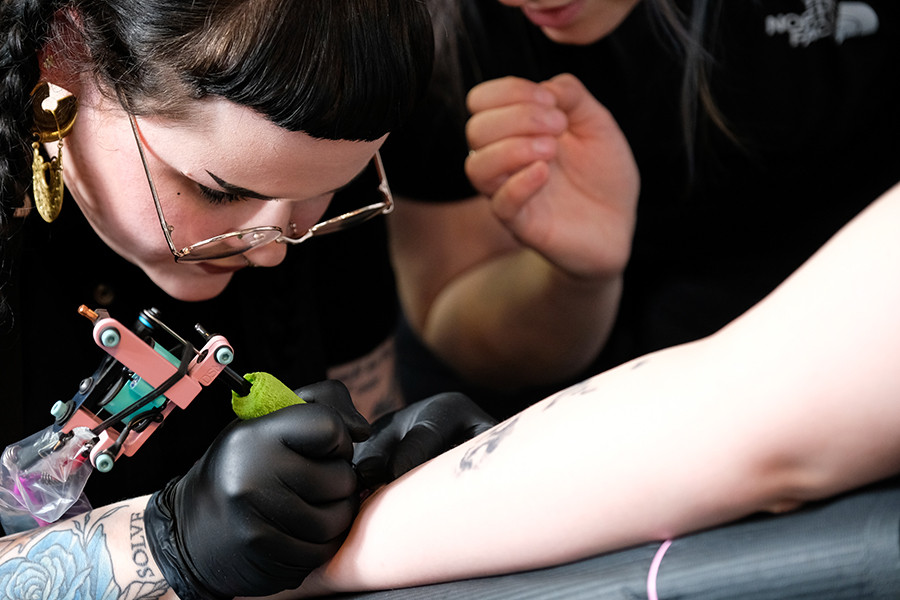
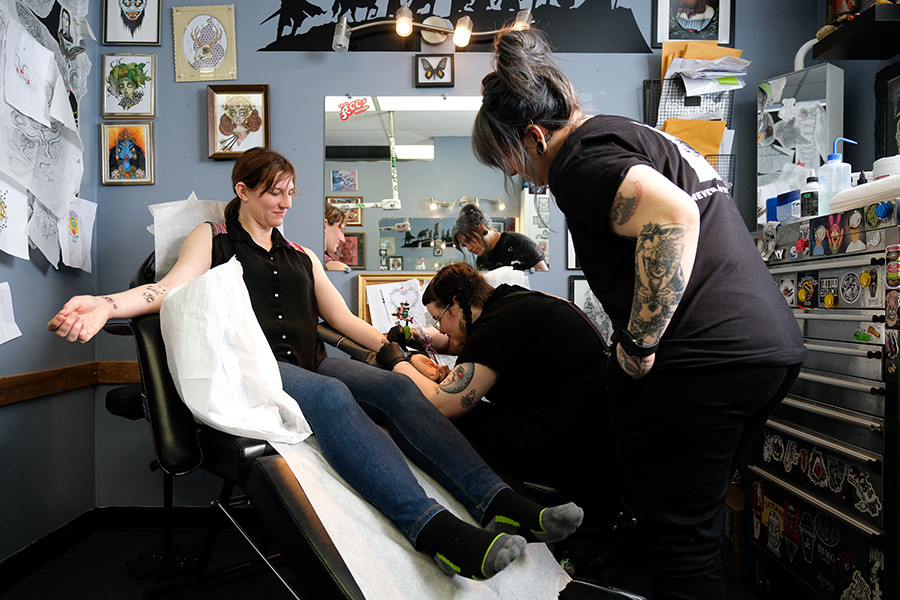
The nitty gritty
The climate surrounding tattooing can be intimidating enough without the added stresses of cultural differences. For Patel, the Winnipeg tattoo scene was a change of pace and an opportunity for fresh beginnings.
She did her masters in information technology and was a graphic designer for four years, but finding the corporate lifestyle stifling, Patel quit to pursue her true passion for tattooing and to develop her artistic talents with freedom.
“My best friend, he’s a good tattoo artist in India ... so I said I really wanted to do this stuff. I wanted to be a full-time artist,” she says.
Forem Patel recently moved to Winnipeg from Vadodara, India to pursue a career in tattooing.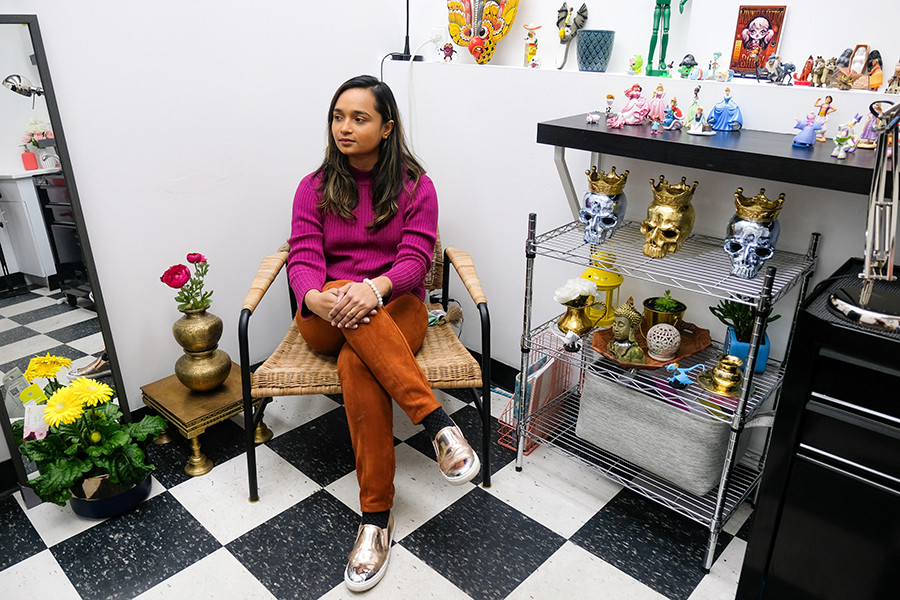
Patel describes every tattoo and every artist as unique, saying she loves that aspect of the art and the process of working with clients to make something special, but then there are logistical matters.
She says “there are lots of different things” to consider when discussing the cultural differences in tattoo communities around the world. “There are not a lot of rules in India,” and she found the regulations to be lax and cautions the risk of tattooing with inexperienced artists.
Because of the rise in popularity of tattoos due to internet sharing, she is glad that Canada requires artists to have body modification certificates, “because tattooing (is) creating an open wound, and we’re dealing with blood.”
Similarly, Melia expresses that her clients will “walk around the shop and look at how we sterilized things if that makes them feel better, or look at our licenses if that makes them feel better.”
Melia says even something as simple as taking off gloves after the piece is completed must be done properly to avoid touching bio-matter.
Despite the more lax tattooing guidelines in India, Patel says there are “a lot of good artists in India and here (in Canada) as well,” noting that many Indian artists are trained and are looking out for the well-being of their clients.
Although her drive and passion led her to apply for every opportunity that crossed her path, Patel says she felt most comfortable spaces filled predominantly by women. An opportunity she secured before starting her time at Ink Noir was with Vanessa Stefanato in her up-and-coming tattoo studio, Witches Brew Tattoo.
Stefanato is originally from Winnipeg but got her start tattooing in Dryden, Ont. at Diamond Tattoo Studio, where she apprenticed under Amanda and Billy Diamond. She currently tattoos out of Last Stand Tattoo Company on Henderson Highway.
She says that it was “actually, one of my uncles (who) suggested to me when I was only 14 that I should be a tattoo artist, and it's kind of stuck from there.”
Her shop was supposed to open up in September of 2019, but she “had a bit of a setback with the City of Winnipeg zoning department.”
“I had got the space in St. Boniface in August, and we worked on it for about a month ... doing all the renovations to get it up to code for having a tattoo shop,” she says.
She had gone through all the necessary steps, passing all the health inspections, but it was ultimately zoning laws that halted the process. Requirements to open a shop will vary from province to province.
“Right now, I’m in the process of finding a new location.”
The cultural atmosphere
Tattooing as an art form, and body modifications in general, have been prominent in different cultures for thousands of years, and they can play many roles depending on context.
Patel describes the difficult politics of tattoos in India and specifically her experiences with her own parents who worry she will be denied opportunities because she has tattoos.
She says “there are traditional tattoos, and there are also lots of tribes that have traditional tattoos in our culture,” but there is a cultural rift between traditional and modern notions of tattooing.
To her mother, Patel says “don’t say that (tattoos) are not in our culture! Because my grandparents have tattoos of Om and of gods and goddesses on their hands, so it is in our culture!”
Patel responded to her family’s discomfort with her profession by pointing out India's long history of traditional tattooing.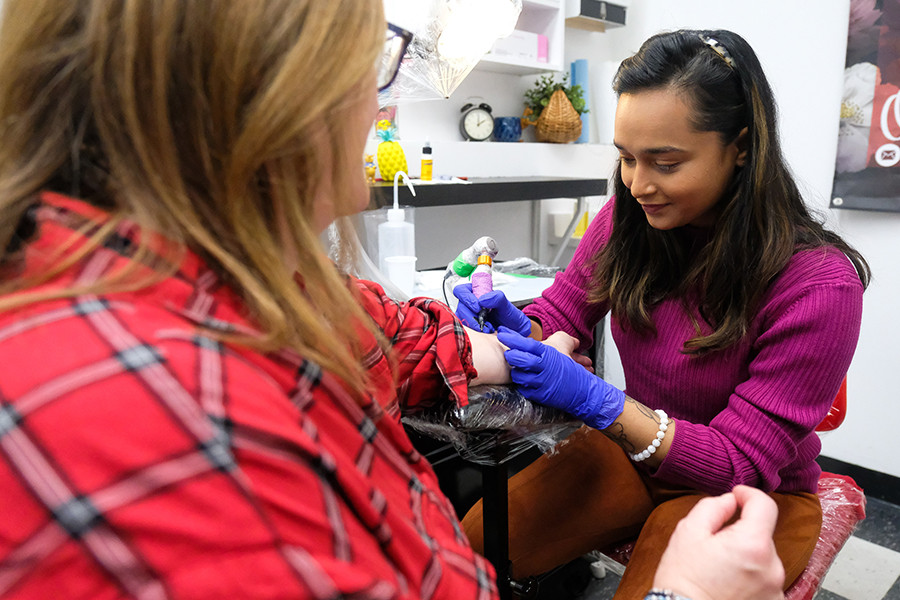
Her mother started laughing and said, “Oh yeah, you are right!”
Patel speaks publicly on her social media accounts to bring attention to the art of her ancestors, explaining that “the old traditional way (is) stick-and-poke.”
Her Instagram post from Oct. 22, 2019 reads “coming from a place where tattoo is accepted as beauty is like a blessing” and that “this is Rabari culture symbols of birds, god, swastika, animals and dot work are included in tattoo design.”
Regarding contemporary western tattooing, Melia says “trends always change with what is popular in entertainment,” and that “hand tattoos and face tattoos” are what’s in at the moment.
“I will not tattoo hands, faces or throats, or anything super visible, unless you’re fully sleeved ... and heavily tattooed.”
Melia and Moon joke that they often have to become “mom” figures for young people. Melia says there is still a stigma surrounding tattoos, and that she does not want people to miss out on professional opportunities because of a misguided decision.
“I feel like it’s very much a situation of ‘just because you can, doesn’t mean that you should,’” Moon says.
That being said, tattoos are a great source of joy for those who love the art and want to express it on their skin. Tattoo enthusiast Christina Livingstone says “I have always loved art and always knew I wanted it on my body. I got my first tattoo when I was 18.”
“I do still receive dirty looks from older people at times, but mostly I have positive reactions,” she says regarding her growing ink collection.
The artist’s appeal
No two tattoo artists will ever be the same, and that’s part of what makes tattooing special. There is a distinct connection between an artist and their artwork, and unique bonds can form between all parties involved.
Livingstone says a “big thing I look for when choosing an artist is their personality/vibe. Being tattooed isn’t exactly enjoyable, so it’s nice to have someone friendly tattooing you.” She plans “to travel the world to get tattooed (by) some amazing artists.”
Melia says “the way I tattoo is very different to the way (Katie’s) going to learn to tattoo,” because “how you like to wrap your grips and hold your machine is different for every person.
“Katie draws very differently than me. She colours with markers ... whereas I use more pencils and pencil crayons.”
Stefanato prefers traditional styles, bold lines and bright colours, and “was actually a pencil artist doing portraits,” something that she says people thought would translate to her style as a tattoo artist.
Patel’s style is summed up in bold line art and black ink, with emphasis on a love for floral designs.
Her workspace might not be what you’d expect with it’s cute design and bright colours, but she says that “when (clients) are coming for the first (time), I do not want them to feel scared” and that “I want to give a welcoming atmosphere.”
City zoning laws were an obstacle for tattoo artist Vanessa Stefanato in opening her own shop.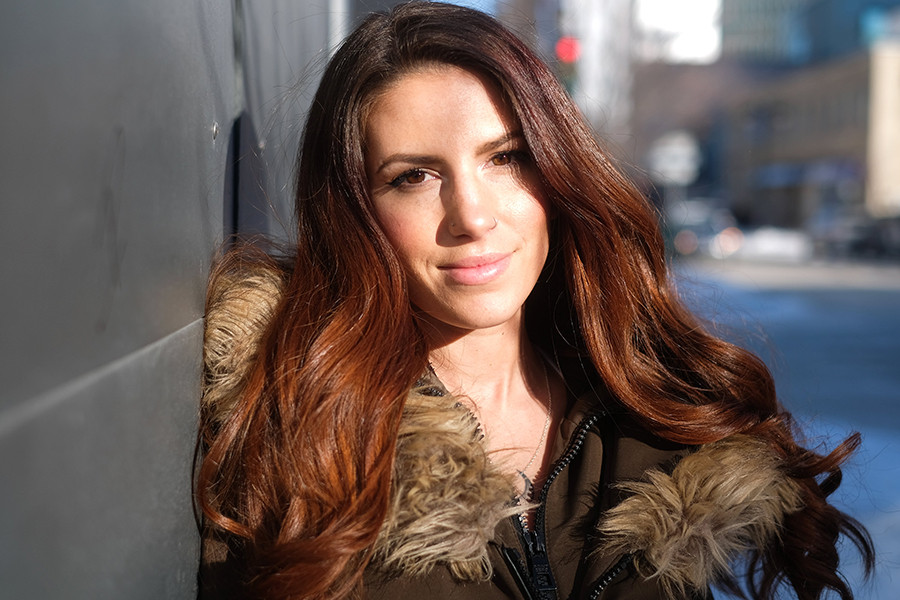
To develop one’s skills and unique style requires a lot of patience and hard work. Melia sometimes gives Moon drawing assignments to practice her skills and develop a larger portfolio.
She will set a deadline, saying “okay, you have a week,” and “here’s three things. Make a design out of it.” This is so Moon is “getting used to clients coming in with very vague ideas,” she says.
While most clients will choose an artist based on their artistic style, this might not be the single defining factor. Stefanato says one of the big draws for her clients is the fact that she is a vegan and cruelty-free artist, and she plans to carry that into her business.
Stefanato says “a lot of products have animal products in them ... so I buy all plant-based (and) cruelty-free as well.”
She says beeswax and other bee products are common in the ointments artists use, but vegan supplies are more readily available. She also mentions this encompasses brands that will not test on animals.
Published in Volume 74, Number 18 of The Uniter (February 13, 2020)

